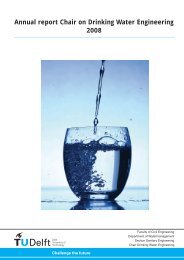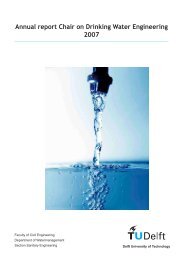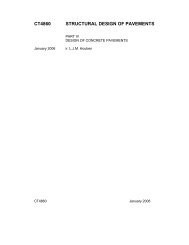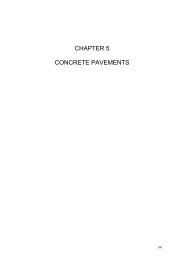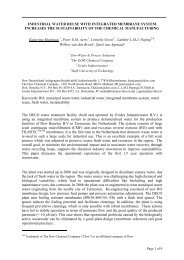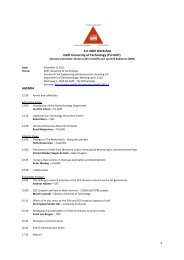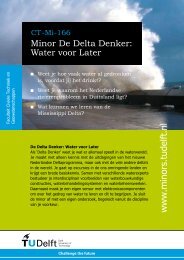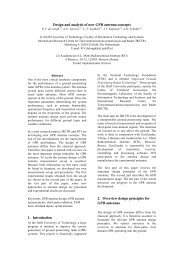Lecture Notes CT 4860 Structural Pavement Design Design of ...
Lecture Notes CT 4860 Structural Pavement Design Design of ...
Lecture Notes CT 4860 Structural Pavement Design Design of ...
Create successful ePaper yourself
Turn your PDF publications into a flip-book with our unique Google optimized e-Paper software.
Given these drawbacks, one realized immediately after the Road Test that mechanistic based<br />
design tools were needed to support the AASHTO Guide designs. For that reason, much work has<br />
been done in the 1960’s on the analysis <strong>of</strong> stresses and strains in layered pavement systems [6,<br />
7, 8, 9] and on the characterization <strong>of</strong> the stiffness, fatigue and permanent deformation<br />
characteristics <strong>of</strong> bound and unbound pavement materials. The work done on the analysis <strong>of</strong><br />
stresses and strains in pavements is all based on early developments by Boussinesq [4] and<br />
Burmister [5]. References [10, 11 and 12] are excellent sources with respect to research on<br />
pavement modeling and material characterization done in those days and should be on the<br />
reading list <strong>of</strong> any student in pavement engineering. It is remarkable to see that much <strong>of</strong> the<br />
material presented then still is <strong>of</strong> high value today.<br />
Since then, much progress has been made and the reader is referred e.g. to the proceedings <strong>of</strong><br />
the conferences organized by the International Society <strong>of</strong> Asphalt <strong>Pavement</strong>s, the proceedings <strong>of</strong><br />
the Association <strong>of</strong> Asphalt <strong>Pavement</strong> Technologists, the Research Records <strong>of</strong> the Transportation<br />
Research Board, the proceedings <strong>of</strong> RILEM conferences on asphalt materials, the proceedings <strong>of</strong><br />
the International Conferences on the Bearing Capacity <strong>of</strong> Roads and Airfields and those <strong>of</strong> many<br />
other international conferences to get informed about these developments.<br />
Given the possibilities we have nowadays with respect to material testing, characterization and<br />
modeling, it is possible to model pavements structures as accurate as possible using non linear<br />
elasto-visco-plastic models and using advanced finite element techniques that allow damage<br />
initiation and progression to be taken into account as well as the effects <strong>of</strong> stress re-distribution<br />
as a result <strong>of</strong> that. Also such methods allow the effects <strong>of</strong> joints, cracks and other geometry<br />
related issues to be taken into account. Furthermore these methods also allow to analyze the<br />
effects <strong>of</strong> moving loads which implies that inertia and damping effects can be taken into account.<br />
The question however is to what extent such advanced methods should be used for solving day<br />
to day problems. This is a relevant question because advanced pavement design methods involve<br />
advanced testing and analyses techniques which require specific hardware and skills.<br />
Furthermore pavement design is to some extent still an empirical effort because many input<br />
parameters cannot be predicted with sufficient accuracy on before hand. Examples <strong>of</strong> such input<br />
parameters are climate, traffic and the quality <strong>of</strong> the materials as laid and the variation therein.<br />
All this means that although advanced methods provide a much better insight in why pavements<br />
behave like they do, one should realize that even with the most advanced methods one only can<br />
achieve a good estimate <strong>of</strong> e.g. pavement performance. Obtaining an accurate prediction is still<br />
impossible. Because <strong>of</strong> this, practice is very much interested in design methods which are, on<br />
one hand, based on sound theoretical principles but, on the other hand, are very user friendly<br />
and require only a limited amount <strong>of</strong> testing in order to save money and time.<br />
One should realize that the need to use accurate modeling is influenced to a very large extent by<br />
the type <strong>of</strong> contracts used for road construction projects. In recipe type contracts, the contractor<br />
is only responsible for producing and laying mixtures in the way as prescribed by the client. In<br />
this case the contractor is neither responsible for the mixture design nor the design <strong>of</strong> the<br />
pavement structure; these are the responsibilities <strong>of</strong> the client. This immediately implies that the<br />
clients in this case will choose “proven” designs and materials, in other words he will rely on<br />
experience, and the contractor has no incentive to spend much effort and resources in advanced<br />
material research and pavement design methods. If however contractors are made more<br />
responsible for what they make, meaning that contractors take over from the authorities the<br />
responsibility for the performance <strong>of</strong> the road over a certain period <strong>of</strong> time, then they are much<br />
more willing to use more advanced ways <strong>of</strong> material testing and pavement design.<br />
The purpose <strong>of</strong> these lecture notes is not to provide an overall picture <strong>of</strong> existing mechanistic<br />
empirical design methods. The goal <strong>of</strong> these notes is to provide an introduction into pavement<br />
design using the analytical methods and material characterization procedures as they are<br />
common practice nowadays in the Netherlands. This implies that we will concentrate in these<br />
notes on the use <strong>of</strong> multi layer linear elastic systems and the material characterization needed to<br />
26



